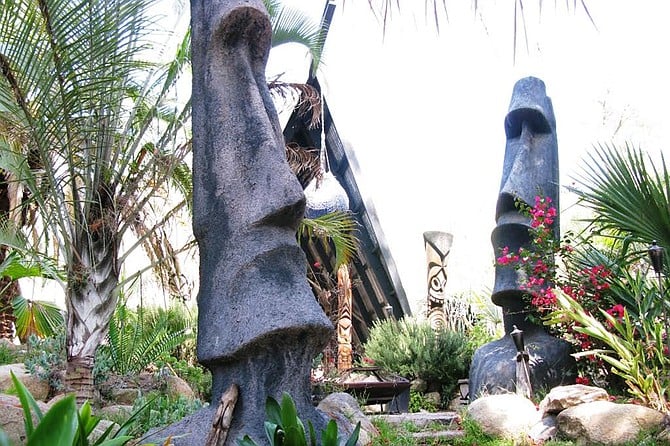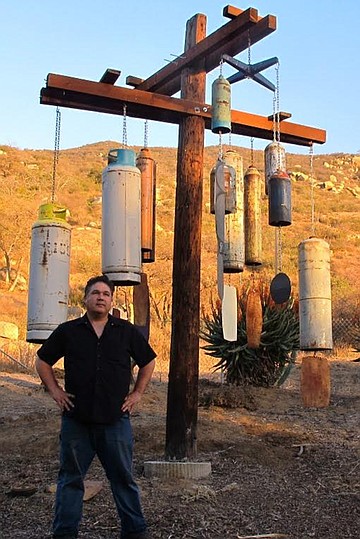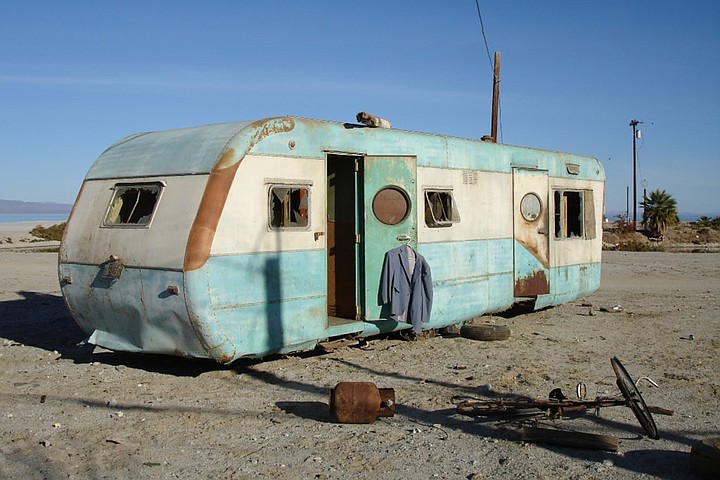 Facebook
Facebook
 X
X
 Instagram
Instagram
 TikTok
TikTok
 Youtube
Youtube

Even if you knew nothing at all about artist Bosko Hrnjak, you could glean a pretty good sense of who the man is and what he cares about just by taking a look around his ample — and amply adorned — property at the edge of Escondido. Like Daniel Pinkwater’s Mr. Plumbean, the colorful hero of the children’s book The Big Orange Splot, Bosko might say, “My house is me and I am it. My house is where I like to be and it looks like all my dreams.”
After you pass the (usually closed) gate with its warning signs, you’ll find yourself amidst an array of exotic plants, curated rocks, a miscellany of antiques, half-planted ceramic shards, and some large-scale outdoor art installations, all set against a ruggedly beautiful mountain backdrop. There are numerous studio and shop spaces; mellow exotica music drifts out of one of them. And you will certainly notice the impressive A-frame hut in which he and his wife, musician Truus de Groot, were married about two decades ago.

His estate notwithstanding, Bosko is most famous for his work as a Tiki artist. He is one of the small handful of people chiefly responsible for the revival of what his friend, writer Sven Kirsten, has dubbed “Polynesian Pop” — midcentury America’s creative reimagining of island leisure paradises. Legions of bars, restaurants, hotels, bowling alleys, and apartment buildings were created in the style during its heyday, only to disappear swiftly after the aesthetic tide turned. Bosko spent his earliest years in LA’s San Gabriel Valley; the time there put him on intimate terms with some of the ruins of the region’s Tiki dream world. And it left a permanent impression that he has been drawing from ever since. His signature contribution to the Tiki revival has been twofold: he was the first artist in decades to carve wooden Tiki figures, and also to make the elaborate ceramic mugs that are meant to hold tropical cocktails. He saw the latter as an overlooked art form all its own. More privately, he created his own home Tiki bar, the extremely cool Kapu Tiki Room, which stands here in his yard— “a museum, an homage to the first movement.” (You may not be able to see the private version, but San Diegans can see the maximalist interior Bosko designed for San Diego’s False Idol bar within Craft & Commerce anytime.)
A charming, voluble speaker who is as humble as he is enthusiastic, Bosko will tell you all about the Tiki part of his creative life as he walks around providing what he says he can make into a one-hour tour or a three-hour tour, depending on your preference. But you will quickly learn that there is more to Bosko than Tiki. “I could spend three hours just talking about plants”, he warns me, just before pointing out some of his rare primitive cycads. “They’re pre-flower; as old as dinosaurs.” I want to hear about the plants — and also the stories of William Westenhaver and Witco furniture, and the weird instruments in the house, and the swizzle sticks and matchbooks — but more than all that, I want to make sure that I hear about Bosko’s work in the desert. I want to see some of the many photographs he has taken as part of his effort to document both the desolation and the surprising beauty of the desert world around the Salton Sea and its neighboring environs.

Happily, he obliges me, and we step into one of his studio rooms. Bosko has many stories to go along with his photographs, and he regales me as we flip through a portfolio, a map of Imperial County laid out beside it. One has to do with being pursued by a man pretending to be a police officer, whom he and Truus evaded. Another, with the discovery of a hotel with a room full of organs belonging at some point in the past to “some kind of musician in Downey.” By the time of his second visit to the spot, the instruments had been completely destroyed by vandals. Numerous stories feature the motif of households whose residents died or simply took off without leaving much of a trace — just sad, humble, hauntingly intact memorials. The desert is strangely full of them, hidden in plain sight throughout Imperial County.
Like the vanishing urban and suburban realms of Tiki that he has explored for decades, the desert provides another creative hotspot for the artist, and he regularly mines it for the discovery of both artifacts and inspiration. There is a common thread for Bosko: “It’s just midcentury America, and where the empire has gone since its peak. That’s what all the work is about… Everything sort of revolves around that, to various degrees.”
Some of his desert photographs went into the Salton Sink project, a collaboration with Truus that the pair presented in Amsterdam, which joins together images and music to evoke the dismal atmosphere of the Salton Sea, that spooky and trashed once-golden dream, a body of water made by a big accident that in another age was a home to bustling resorts and smiling vacationers on water skis. The whole place once served as a peppy icon of California’s good life. Today, the sea continues its gradual metamorphosis into a mass of poisonous dust.
At the time of that project’s origin a little more than a decade ago, Bosko hoped that some ecological good could come from it. At the time, he says, there was still some hope, at least more than there is now. “At the time, you still could have saved it,” he believes. He didn’t have much luck. Despite the power of the work and the importance of its subject, “Nobody wanted to touch it.”
But the photos remain — go see them at saltonsink.com — and Bosko remains as busy as ever with his pursuits: paintings, Tikis, mugs, urban archeology. Keep up with his work at tikibosko.com.


Even if you knew nothing at all about artist Bosko Hrnjak, you could glean a pretty good sense of who the man is and what he cares about just by taking a look around his ample — and amply adorned — property at the edge of Escondido. Like Daniel Pinkwater’s Mr. Plumbean, the colorful hero of the children’s book The Big Orange Splot, Bosko might say, “My house is me and I am it. My house is where I like to be and it looks like all my dreams.”
After you pass the (usually closed) gate with its warning signs, you’ll find yourself amidst an array of exotic plants, curated rocks, a miscellany of antiques, half-planted ceramic shards, and some large-scale outdoor art installations, all set against a ruggedly beautiful mountain backdrop. There are numerous studio and shop spaces; mellow exotica music drifts out of one of them. And you will certainly notice the impressive A-frame hut in which he and his wife, musician Truus de Groot, were married about two decades ago.

His estate notwithstanding, Bosko is most famous for his work as a Tiki artist. He is one of the small handful of people chiefly responsible for the revival of what his friend, writer Sven Kirsten, has dubbed “Polynesian Pop” — midcentury America’s creative reimagining of island leisure paradises. Legions of bars, restaurants, hotels, bowling alleys, and apartment buildings were created in the style during its heyday, only to disappear swiftly after the aesthetic tide turned. Bosko spent his earliest years in LA’s San Gabriel Valley; the time there put him on intimate terms with some of the ruins of the region’s Tiki dream world. And it left a permanent impression that he has been drawing from ever since. His signature contribution to the Tiki revival has been twofold: he was the first artist in decades to carve wooden Tiki figures, and also to make the elaborate ceramic mugs that are meant to hold tropical cocktails. He saw the latter as an overlooked art form all its own. More privately, he created his own home Tiki bar, the extremely cool Kapu Tiki Room, which stands here in his yard— “a museum, an homage to the first movement.” (You may not be able to see the private version, but San Diegans can see the maximalist interior Bosko designed for San Diego’s False Idol bar within Craft & Commerce anytime.)
A charming, voluble speaker who is as humble as he is enthusiastic, Bosko will tell you all about the Tiki part of his creative life as he walks around providing what he says he can make into a one-hour tour or a three-hour tour, depending on your preference. But you will quickly learn that there is more to Bosko than Tiki. “I could spend three hours just talking about plants”, he warns me, just before pointing out some of his rare primitive cycads. “They’re pre-flower; as old as dinosaurs.” I want to hear about the plants — and also the stories of William Westenhaver and Witco furniture, and the weird instruments in the house, and the swizzle sticks and matchbooks — but more than all that, I want to make sure that I hear about Bosko’s work in the desert. I want to see some of the many photographs he has taken as part of his effort to document both the desolation and the surprising beauty of the desert world around the Salton Sea and its neighboring environs.

Happily, he obliges me, and we step into one of his studio rooms. Bosko has many stories to go along with his photographs, and he regales me as we flip through a portfolio, a map of Imperial County laid out beside it. One has to do with being pursued by a man pretending to be a police officer, whom he and Truus evaded. Another, with the discovery of a hotel with a room full of organs belonging at some point in the past to “some kind of musician in Downey.” By the time of his second visit to the spot, the instruments had been completely destroyed by vandals. Numerous stories feature the motif of households whose residents died or simply took off without leaving much of a trace — just sad, humble, hauntingly intact memorials. The desert is strangely full of them, hidden in plain sight throughout Imperial County.
Like the vanishing urban and suburban realms of Tiki that he has explored for decades, the desert provides another creative hotspot for the artist, and he regularly mines it for the discovery of both artifacts and inspiration. There is a common thread for Bosko: “It’s just midcentury America, and where the empire has gone since its peak. That’s what all the work is about… Everything sort of revolves around that, to various degrees.”
Some of his desert photographs went into the Salton Sink project, a collaboration with Truus that the pair presented in Amsterdam, which joins together images and music to evoke the dismal atmosphere of the Salton Sea, that spooky and trashed once-golden dream, a body of water made by a big accident that in another age was a home to bustling resorts and smiling vacationers on water skis. The whole place once served as a peppy icon of California’s good life. Today, the sea continues its gradual metamorphosis into a mass of poisonous dust.
At the time of that project’s origin a little more than a decade ago, Bosko hoped that some ecological good could come from it. At the time, he says, there was still some hope, at least more than there is now. “At the time, you still could have saved it,” he believes. He didn’t have much luck. Despite the power of the work and the importance of its subject, “Nobody wanted to touch it.”
But the photos remain — go see them at saltonsink.com — and Bosko remains as busy as ever with his pursuits: paintings, Tikis, mugs, urban archeology. Keep up with his work at tikibosko.com.
Comments